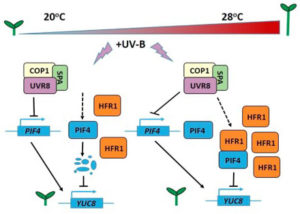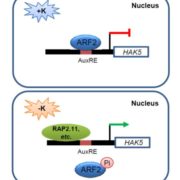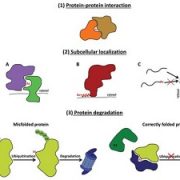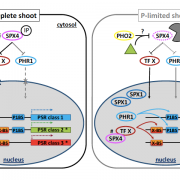UV-B perceived by the UVR8 photoreceptor inhibits plant thermomorphogenesis
 Ambient temperature can influence plant architecture, an effect termed thermomorphogenesis. In A. thaliana, thermomorphogenesis phenotypes include stem elongation and changes in leaf elevation angles. Increased auxin biosynthesis involving the transcription factor PIF4 is required for thermomorphogenesis, but the roles of other signals besides auxin remain unknown. Hayes et al. studied how ultraviolet-B (UV-B) light perceived through the photoreceptor UVR8 influences thermomorphogenesis using duplicate experiments at 20°C & 28°C. At 20°C & 28°C, PIF4 transcript abundance and thermomorphogenesis are both inhibited by signaling from heterodimers of UVR8 and the E3 ubiquitin ligase COP1. This is consistent with the decrease in PIF4 protein levels seen at 20°C, but there is no similar decrease for 28°C. At 28°C, the PIF4 protein is postulated to lose activity, and this loss is attributed to PIF4 binding to the bHLH protein HFR1 to form heterodimers that cannot bind DNA. UV-B light uses multiple mechanisms to inhibit thermomorphogenesis, and this explains one facet of how a plant interacts with and adapts to its environment. (Summary by Daniel Czerny) Curr. Biol. 10.1016/j.cub.2016.11.004
Ambient temperature can influence plant architecture, an effect termed thermomorphogenesis. In A. thaliana, thermomorphogenesis phenotypes include stem elongation and changes in leaf elevation angles. Increased auxin biosynthesis involving the transcription factor PIF4 is required for thermomorphogenesis, but the roles of other signals besides auxin remain unknown. Hayes et al. studied how ultraviolet-B (UV-B) light perceived through the photoreceptor UVR8 influences thermomorphogenesis using duplicate experiments at 20°C & 28°C. At 20°C & 28°C, PIF4 transcript abundance and thermomorphogenesis are both inhibited by signaling from heterodimers of UVR8 and the E3 ubiquitin ligase COP1. This is consistent with the decrease in PIF4 protein levels seen at 20°C, but there is no similar decrease for 28°C. At 28°C, the PIF4 protein is postulated to lose activity, and this loss is attributed to PIF4 binding to the bHLH protein HFR1 to form heterodimers that cannot bind DNA. UV-B light uses multiple mechanisms to inhibit thermomorphogenesis, and this explains one facet of how a plant interacts with and adapts to its environment. (Summary by Daniel Czerny) Curr. Biol. 10.1016/j.cub.2016.11.004










Leave a Reply
Want to join the discussion?Feel free to contribute!